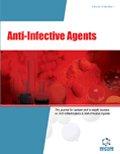Abstract
Active efflux is a wide-spread mechanism for bacterial resistance to antibiotics, which contributes to poor intrinsic susceptibility, cross-resistance to structurally diverse classes of drugs, or selection of other mechanisms of resistance. Thus, inhibition of efflux pumps appears to be (i) a promising strategy for restoring the activity of existing antibiotics, and (ii) a useful method to detect the presence of efflux determinants in clinical isolates. Structurally dissimilar classes of inhibitors have been patented in the last decade, some are analogues of antibiotic substrates [tetracyclines, quinolones or aminoglycosides] and others are new chemical entities [including substituted indoles, ureas, aromatic amides, piperidinecarboxylic acids, alkylamino- or alkoxyquinolines, peptidomimetics, and pyridopyrimidines]. Their spectrum of activity, in terms of companion antibiotics and bacteria, differ significantly. Narrow spectrum inhibitors are of prime interest as diagnostic tools, while broad spectrum inhibitors are expected for adjuvant therapies. Apart from (i) a peptidomimetic inhibitor of Mex pumps in Pseudomonas aeruginosa (MC-04,124), for which efficacy was evaluated in animal models, and (ii) a piperidinecarboxylic acid inhibitor of fluoroquinolone efflux in Gram-positive (VX-710), which was safely administered to humans, most of these products have only demonstrated their activity in vitro, so further investigations are needed to evaluate their clinical potential.
Keywords: Efflux pumps, resistance, S.aureus, S.pneumoniae, H.influenzae, E.coli, P.aeruginosa, E.aerogenes, reserpine, indoles, ureas, aromatic amides, piperidine-carboxylic acid derivatives, quinolines, peptidomimetics






















